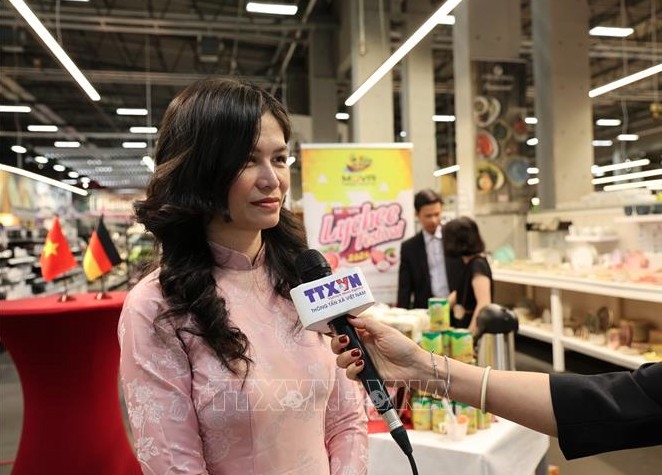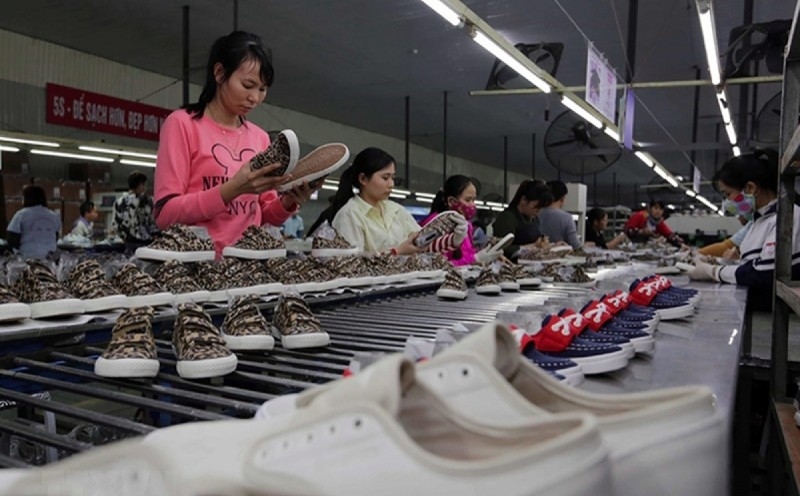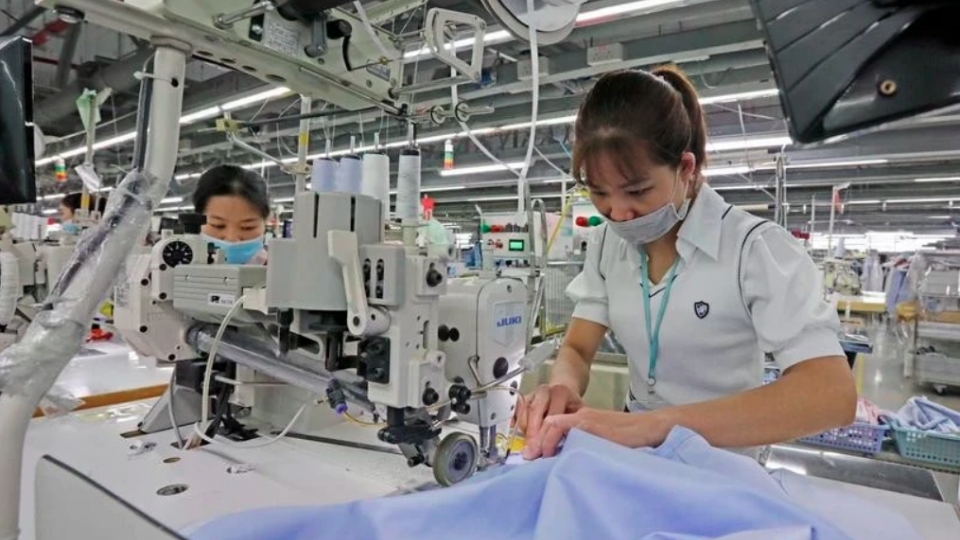Five years of EVFTA keep Vietnam-EU trade on stable ground
VOV.VN - Vietnam’s Trade Counsellor in Germany, Dang Thi Thanh Phuong, has recently shared an overview of the achievements and outlook of the EU-Vietnam Free Trade Agreement (EVFTA) during a media interview in Berlin, marking five years since the agreement officially took effect in August 2020.

According to her, the EVFTA represents a major step forward in strengthening economic ties between Vietnam and the EU. It has opened up a wealth of opportunities for Vietnamese businesses, though not without posing a number of challenges that require ongoing efforts to overcome.
According to data from Vietnam Customs, bilateral trade between Vietnam and the EU grew by 46.5% between 2020 and 2024, reaching over US$64.6 billion, up from US$44.1 billion in the previous five-year period. Vietnam’s exports to the EU rose by 56.4%, from US$31.1 billion to nearly US$48.7 billion, while imports from the bloc increased by 13%, from US$14 billion to US$15.9 billion.
In the German market specifically, bilateral trade also recorded positive growth of 17%, with Vietnam’s exports to Germany surging by 20% and imports from Germany increasing by 13%.
While there has yet to be a marked breakthrough, the EVFTA has played a key role in sustaining the growth momentum of Vietnam–EU trade amid global disruptions such as the COVID-19 pandemic, the Russia–Ukraine conflict, and widespread supply chain fragmentation.
According to Counsellor Phuong, the EVFTA has created major opportunities for Vietnam’s key export sectors to capitalize on the elimination of import tariffs. As soon as the agreement came into force, the EU removed import duties on 85.6% of tariff lines, equivalent to 70.3% of Vietnamese export value to the EU. After seven years, this figure is expected to rise to 99.2%, meaning nearly all of Vietnam’s exports to the bloc will benefit from preferential tariffs.
Several product groups, such as rice, coffee, seafood, fruit and vegetables, garments and textiles, and footwear, have been eligible for 0% tariff rates from the outset, enabling Vietnamese businesses to boost their competitiveness and expand into new markets.
This advantage has been especially evident in agricultural and aquatic products such as coffee, seafood, cashew nuts, and tea, which have seen strong growth. Specifically, Vietnam’s coffee exports to the EU soared by 120%, from US$983 million in 2020 to US$2.2 billion in 2024. Fruit and vegetable exports rose by 65.6%, from US$146 million to US$242 million. Footwear exports grew by 52.4%, from US$3.7 billion to US$5.65 billion. These results clearly demonstrate the effective use of EVFTA tariff preferences, particularly by major enterprises that have focused on improving product quality, meeting rules of origin requirements, and building sustainable brands.

However, Counsellor Dang Thi Thanh Phuong noted that sectors such as garments and textiles, footwear, wood products, and pharmaceuticals still face numerous challenges in fully leveraging the EVFTA’s benefits. The main obstacles stem from internal factors such as outdated production technology, limited investment in design and branding, and difficulties in meeting origin requirements. In addition, technical barriers and stringent standards on product origin, technology, and design continue to limit the competitiveness of many Vietnamese enterprises.
In addition, according to Phuong, the pharmaceutical industry has yet to show meaningful progress, mainly due to weak domestic capacity, the absence of EU-standard GMP certification, and limited competitiveness against European generics. In the wood processing sector, the drop in export value highlights the challenges enterprises face in proving legal timber origin and adapting production technologies to meet evolving market demands.
Echoing the view shared by many trade experts that the EVFTA has served as a driver for institutional reform and sustainable development in Vietnam, particularly through its provisions on labor, environmental standards, and intellectual property, Counsellor Phuong noted that Vietnam has made clear efforts to align with these commitments.
These include ratifying key ILO conventions such as Convention No. 98 on the right to organize and to engage in collective negotiations between workers and employers, and Convention No. 105 on the abolition of forced labor. The implementation of the revised Labor Code, effective from 2021, has also allowed for the establishment of worker representative organizations at the enterprise level outside the official Vietnam General Confederation of Labor system, bringing domestic regulations more closely in line with EVFTA requirements.
Additionally, Vietnam has passed the 2020 Law on Environmental Protection, which emphasizes sustainable development, extended producer responsibility (EPR), environmental impact assessment, and greater community participation. The country is also carrying out its commitments under the 26th UN Climate Change Conference of the Parties (COP26), including the target of achieving net-zero emissions by 2050.
In 2022, Vietnam amended its Law on Intellectual Property to strengthen IP protection. The revisions clarified regulations on geographical indications, patents, and copyright, improved enforcement mechanisms, and increased penalties and measures for IP violations.
It can be said that Vietnam has made great strides in institutional reform to implement the EVFTA, particularly in the areas of labor, the environment, and intellectual property. However, practical implementation still faces a number of limitations – for example, the effectiveness of labor organizations, the enforcement of intellectual property rights, and the consistency of environmental law enforcement remain uneven.
Continued efforts are needed to intensify the effective implementation of commitments, accelerate the participation of businesses and the public, raise awareness among enterprises about the EVFTA and relevant international standards, and further improve regulatory transparency, public accountability, and international cooperation.
Counsellor Dang Thi Thanh Phuong noted that the implementation of the EVFTA is expected to continue benefiting Vietnamese businesses, as more products will enjoy further tariff reductions. By 2027, the EU is set to eliminate around 99.2% of tariff lines, covering approximately 99.7% of Vietnam’s export revenue to the bloc.
She added that in the current context, where the United States is tightening trade measures against several countries, both the EU and Vietnam must diversify their markets and partners. Vietnam holds a significant advantage in this regard, having already signed a free trade agreement with the EU that includes ambitious tariff commitments across many of its key export categories.
To fully realize the long-term benefits of the EVFTA, Counsellor Dang Thi Thanh Phuong emphasized that Vietnam must take stronger steps to upgrade its production capacity, speed up green and sustainable transformation, develop high-quality human resources, and boost localization. This is not only an opportunity to expand market access, but also a lever to shift the country’s growth model and enhance Vietnam’s position in regional and global value chains.
She further noted that as the EU steps up its market diversification efforts, having signed a free trade agreement with the MERCOSUR bloc in December 2024 and actively negotiating FTAs with Thailand, Indonesia, Australia, and New Zealand, Vietnamese enterprises must act quickly to sharpen their competitiveness and meet market standards. Otherwise, they risk losing their current advantages, especially as direct competitors gain similar access to the EU through existing and upcoming FTAs.




